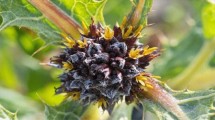Abstract
Vernonia galamensis is a good source of seed oil rich in epoxy acid, which can be used to manufacture plastic formulations, protective coatings, and other products. Seed from a natural stand in Ethiopia contained 31% epoxy acid. Under cultivation in Kenya, this unimproved germplasm produced a substantial yield of seed with 32% epoxy acid. This African species has good natural seed retention and is a promising new crop for semiarid tropical areas.
Similar content being viewed by others
Literature Cited
Asaka, Y., T. Kubota, and A. B. Kulkarni. 1977. Studies on a bitter principle fromVernonia anthelmintica. Phytochemistry 16: 1838–1839.
Berry, C. D., and K. J. Lessman. 1969a. Controlled crossing and inheritance of flower color inVernonia anthelmintica. J. Heredity 60: 75–78.
—, and —. 1969b. Dehulling and seed germination inVernonia anthelmintica (L.) Willd. Crop Sci. 9: 247–249.
—, —, and G. A. White. 1970a. Natural cross-fertilization inVernonia anthelmintica (L.) Willd. Crop Sci. 10: 104–105.
—, —, —, and F. R. Earle. 1970b. Genetic diversity inherent inVernonia anthelmintica (L.) Willd. Crop Sci. 10: 178–180.
Bohlmann, F., J. Jakupovic, R. K. Gupta, R. M. King, and H. Robinson. 1981a. Allenic germacranolides, bourbonene derived lactones and other constituents fromVernonia species. Phytochemistry 20: 473–480.
—, P. Singh, N. Borthakur, and J. Jakupovic. 1981b. Three bourbonenolides and other sesquiterpene lactones fromVernonia species. Phytochemistry 20: 2379–2382.
Carlson, K. D., W. J. Schneider, S. P. Chang, and L. H. Princen. 1981.Vernonia galamensis seed oil: a new source for epoxy coatings. Amer. Oil Chem. Soc. Monogr. 9: 297–318.
—, and S. P. Chang. 1985. Chemical epoxidation of a natural unsaturated epoxy seed oil fromVernonia galamensis and a look at epoxy oil markets. J. Amer. Oil Chem. Soc. 62: 934–939.
Earle, F. R., I. A. Wolff, and Q. Jones. 1960. Search for new industrial oils. III. Oils from Compositae. J. Amer. Oil Chem. Soc. 37: 254–256.
Gilbert, M. G. 1986. Notes on East African Vernonieae (Compositae). 4. A revision of theVernonia galamensis complex. Kew Bull. 41(1): In press.
Gunstone, F. D. 1954. Fatty acids. Part II. The nature of the oxygenated acid present inVernonia anthelmintica (Willd.) seed oil. J. Chem. Soc. (London). May: 1611–1616.
Higgins, J. J. 1968.Vernonia anthelmintica: A potential seed oil source of epoxy acid. I. Phenology of seed yield. Agron. J. 60: 55–58.
—, and G. A. White. 1968.Vernonia anthelmintica: A potential seed oil source of epoxy acid. II. Effects of cultural practices, seed maturity, and after-ripening conditions on germination. Agron. J. 60:59–61.
Jones, S. B., Jr. 1981. Synoptic classification and pollen morphology ofVernonia (Compositae: Vernonieae) in the Old World. Rhodora 83: 59–75.
Krewson, C. F., 1968. Naturally occurring epoxy oils. J. Amer. Oil Chem. Soc. 45: 250–256.
—, C. L. Ogg, F. J. Oelshlegel, Jr., R. Hale, and A. H. Hale. 1965. Processing ironweed(Vernonia anthelmintica) seed in a soybean extraction pilot plant. J. Amer. Oil Chem. Soc. 42: 563–565.
—, G. R. Riser, and W. E. Scott. 1966.Euphorbia andVernonia seed oil products as plasticizerstabilizers for polyvinyl chloride. J. Amer. Oil Chem. Soc. 43: 377–379.
Kupchan, S. M., R. J. Hemingway, D. Werner, A. Karim, A. T. McPhail, and G. A. Sim. 1968. Vernolepin, a novel elemanolide dilactone tumor inhibitor fromVernonia hymenolepis. J. Amer. Chem. Soc. 90: 3596–3597.
—, —, —, and —. 1969a. Tumor inhibitors. XLVI. Vernolepin, a novel sesquiterpene dilactone tumor inhibitor fromVernonia hymenolepis A. Rich. J. Org. Chem. 34: 3903–3908.
—, —, A. Karim, and D. Werner. 1969b. Tumor inhibitors. XLVII. Vernodalin and vernomygdin, two new cytotoxic sesquiterpene lactones fromVernonia amygdalina Del. J. Org. Chem. 34: 3908–3911.
Laekeman, G.M., J. Mertens, J. Totté, H. Bult, A. J. Vlietinck, and A. G. Herman. 1983. Isolation and pharmacological characterization of vernolepin. J. Nat. Prod. 46: 161–169.
Lai, W. Y., and K. J. Lessman. 1974. Combining ability for eight characters of a four-parent diallel cross inVernonia anthelmintica (L.) Willd. Crop Sci. 14: 569–571.
Massey, J. H. 1971. HarvestingVernonia anthelmintica (L.) Willd. to reduce seed shattering losses. Agron. J. 63:812.
Princen, L. H. 1979. New crop developments for industrial oils. J. Amer. Oil Chem. Soc. 56: 845–848.
—. 1982. Alternate industrial feedstocks from agriculture. Econ. Bot. 36: 302–312.
Riser, G. R., J. J. Hunter, J. S. Ard, and L. P. Witnauer. 1962.Vernonia anthelmintica Willd. Seed oil and salts of vernolic acid as stabilizers for plasticized poly (vinyl chloride). J. Amer. Oil Chem. Soc. 39: 266–268.
—, R. W. Riemenschneider, and L. P. Witnauer. 1966. Vernolic acid esters as plasticizers for polyvinyl chloride. J. Amer. Oil Chem. Soc. 43: 456–457.
Smith, C. E., Jr. 1971. Observations on Stengelioid species ofVernonia. Agriculture Handbook No. 396. Agricultural Research Service, USDA, Washington, DC.
Smith, C. R., Jr., K. F. Koch, and I. A. Wolff. 1959. Isolation of vernolic acid fromVernonia anthelmintica oil. J. Amer. Oil Chem. Soc. 36: 219–220.
Sperling, L. H., and J. A. Manson. 1983. Interpenetrating polymer networks from triglyceride oils containing special functional groups: a brief review. J. Amer. Oil Chem. Soc. 60: 1887–1892.
Toubiana, R., and A. Gaudemer. 1967. Structure du vernolide, nouvel ester sesquiterpenique isole deVernonia colorata. Tetrahedron Lett. 14: 1333–1336.
VanEtten, C. H., R. W. Miller, I. A. Wolff, and Q. Jones. 1961. Amino acid composition of twenty-seven selected seed meals. J. Agric. Food Chem. 9: 79–82.
Wernstedt, F.L. 1972. World Climatic Data. Climatic Data Press, Lemont, PA.
White, G. A., and L. N. Bass. 1971.Vernonia anthelmintica: A potential seed oil source of epoxy acid. III. Effects of line, harvest date, and seed storage on germination. Agron. J. 63: 439–441.
—, and F. R. Earle. 1971.Vernonia anthelmintica: A potential seed oil source of epoxy acid. IV. Effects of line, harvest date, and seed storage on quantity and quality of oil. Agron. J. 63: 441–443.
Wild, H. 1978. The Compositae of the Flora Zambesiaca Ara 8-Vernonieae(Vernonia). Kirkia 11: 31–127, and errata.
Author information
Authors and Affiliations
Rights and permissions
About this article
Cite this article
Perdue, R.E., Carlson, K.D. & Gilbert, M.G. Vernonia galamensis, Potential new crop source of epoxy acid. Econ Bot 40, 54–68 (1986). https://doi.org/10.1007/BF02858947
Received:
Accepted:
Issue Date:
DOI: https://doi.org/10.1007/BF02858947




